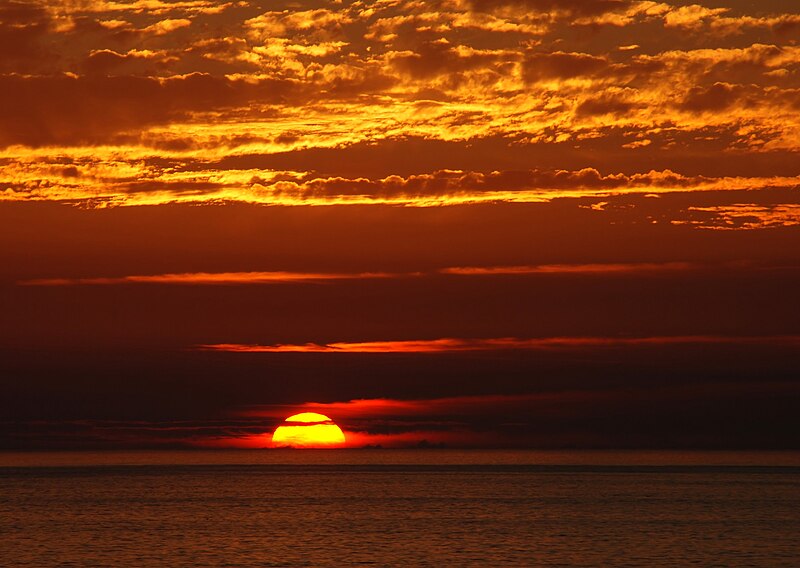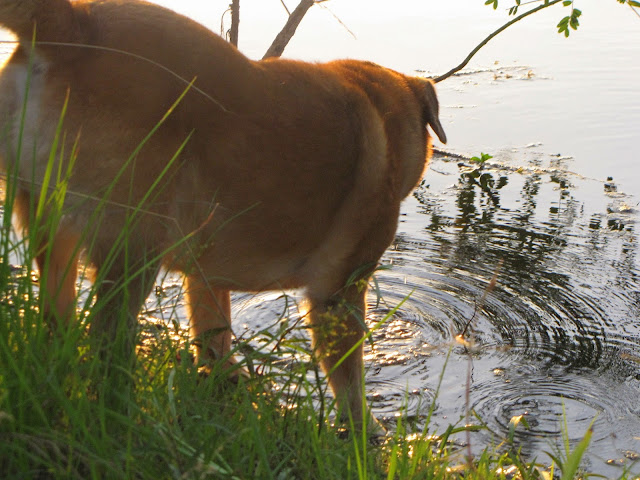
Sunset
From Wikipedia, the free encyclopedia
Sunset or sundown is the daily disappearance of the Sun below the horizon in the westas a result of Earth's rotation.
The time of sunset is defined in astronomy as the moment when the trailing edge of the Sun's disk disappears below the horizon in the west. The ray path of light from the setting Sun is highly distorted near the horizon because of atmospheric refraction, making the sunset appear to occur when the Sun’s disk is already about one diameter below the horizon. Sunset is distinct from dusk, which is the moment at which darkness falls, which occurs when the Sun is approximately eighteen degrees below the horizon. The period between sunset and dusk is called twilight.
Locations north of the Arctic Circle and south of the Antarctic Circle experience no sunset or sunrise at least one day of the year, when the polar day or the polar night persist continuously for 24 hours
Colors
Ash from volcanic eruptions, trapped within the troposphere, tends to mute sunset and sunrise colors, while volcanic ejecta that is instead lofted into the stratosphere (as thin clouds of tiny sulfuric acid droplets), can yield beautiful post-sunset colors calledafterglows and pre-sunrise glows. A number of eruptions, including those of Mount Pinatubo in 1991 and Krakatoa in 1883, have produced sufficiently high stratospheric sulfuric acid clouds to yield remarkable sunset afterglows (and pre-sunrise glows) around the world. The high altitude clouds serve to reflect strongly-reddened sunlight still striking the stratosphere after sunset, down to the surface.
Sunset colors are typically more brilliant than sunrise colors, because the evening air contains more particles than morning air.[4][5][7][10]As a ray of white sunlight travels through the atmosphere to an observer, some of the colors are scattered out of the beam by air molecules and airborne particles, changing the final color of the beam the viewer sees. Because the shorter wavelength components, such as blue and green, scatter more strongly, these colors are preferentially removed from the beam.[4] At sunrise and sunset, when the path through the atmosphere is longer, the blue and green components are removed almost completely leaving the longer wavelength orange and red hues we see at those times. The remaining reddened sunlight can then be scattered by cloud droplets and other relatively large particles to light up the horizon red and orange.[5] The removal of the shorter wavelengths of light is due to Rayleigh scattering by air molecules and particles much smaller than the wavelength of visible light (less than 50 nm in diameter).[6][7] The scattering by cloud droplets and other particles with diameters comparable to or larger than the sunlight's wavelengths (> 600 nm) is due to Mie scattering and is not strongly wavelength-dependent. Mie scattering is responsible for the light scattered by clouds, and also for the daytime halo of white light around the sun (forward scattering of white light). Without Mie scattering at sunset and sunrise, the sky along the horizon has only a dull-reddish appearance, while the rest of the sky remains mostly blue and sometimes green.[8][9][10]
Sunset colors are typically more brilliant than sunrise colors, because the evening air contains more particles than morning air.[4][5][7][10]As a ray of white sunlight travels through the atmosphere to an observer, some of the colors are scattered out of the beam by air molecules and airborne particles, changing the final color of the beam the viewer sees. Because the shorter wavelength components, such as blue and green, scatter more strongly, these colors are preferentially removed from the beam.[4] At sunrise and sunset, when the path through the atmosphere is longer, the blue and green components are removed almost completely leaving the longer wavelength orange and red hues we see at those times. The remaining reddened sunlight can then be scattered by cloud droplets and other relatively large particles to light up the horizon red and orange.[5] The removal of the shorter wavelengths of light is due to Rayleigh scattering by air molecules and particles much smaller than the wavelength of visible light (less than 50 nm in diameter).[6][7] The scattering by cloud droplets and other particles with diameters comparable to or larger than the sunlight's wavelengths (> 600 nm) is due to Mie scattering and is not strongly wavelength-dependent. Mie scattering is responsible for the light scattered by clouds, and also for the daytime halo of white light around the sun (forward scattering of white light). Without Mie scattering at sunset and sunrise, the sky along the horizon has only a dull-reddish appearance, while the rest of the sky remains mostly blue and sometimes green.[8][9][10]
Sometimes just before sunrise or after sunset a green flash can be seen.
Just Push Play
Golden hour (photography)
From Wikipedia, the free encyclopedia
In photography, the golden hour (sometimes known as magic hour, especially incinematography) is the first and last hour of sunlight during the day,[1] when a specific photographic effect is achieved due to the quality of the light.
Overview
Typically, lighting is softer (more diffuse) and warmer in hue, and shadows are longer. When the sun is near the horizon, sunlight travels through more of the atmosphere, reducing the intensity of the direct light, so that more of the illumination comes fromindirect light from the sky (Thomas 1973, 9–13), reducing the lighting ratio. More blue light is scattered, so that light from the sun appears more reddish. In addition, the sun's small angle with the horizon produces longer shadows.
“Hour” is used here quite loosely. The character of the lighting is determined by the sun'saltitude, and the time for the sun to move from the horizon to a specified altitude depends on a location's latitude and the time of year[2] (Bermingham 2003, 214). In Los Angeles, California, at an hour after sunrise or an hour before sunset, the sun has an altitude of about 10°–12°.[3] For a location closer to the equator, the altitude is greater (or the time less), and for a location farther from the equator, the altitude is less (or the time greater). For a location sufficiently far from the equator, the sun may not reach an altitude of 10°, and the golden hour lasts for the entire day in certain seasons.
In the middle of the day, the bright overhead sun can create too-bright highlights and darkshadows. The degree to which overexposure can occur varies because different types of film and digital cameras have different dynamic ranges. This harsh-lighting problem is particularly important in portrait photography, where a fill flash is often necessary to balance lighting across the subject's face or body, filling in strong shadows that are usually considered undesirable.
Because the contrast is less during the golden hour, shadows are less dark, and highlights are less likely to be overexposed. Inlandscape photography, the warm color of the low sun is often considered desirable to enhance the colours of the scene.
Film director Terrence Malick has used this technique in films such as Days of Heaven (Singleton 2000, 176) and The New World, and film director Stanley Kubrick made extensive use of the golden hour in Full Metal Jacket among others.

Bangkok during the golden hour

Golden hour in Dörflingen, Switzerland on a cold winter day.
Hi Everybody!! Hope You are enjoying the
Sunsets! A few days ago on June 15, I noticed
some tall white clouds building up above the tree line.
I asked my dog, the Little King, if he wanted to take a ride
in the car to my secret road where I go to view the Big Sky.
This road is surrounded by vacant property that has been
divided into lots that are for sale. For 2 years no one
has purchased the land, so no one is ever there!! I park the
car on the road and just walk with the dog. To the west is
the sunset over a pond. To the east is a huge thunderhead
cloud growing tall white exploding clouds with rainstorm
occurring below the clouds. This is what I have come to see.As the sun sets, the white clouds change color and seem
to glow. I began the photoshoot at 6:51pm and shot the last
pic at 7:33. The next video is a slide show of the complete
sunset. Enjoy the Golden Clouds!
The red dot on left (above) is my Thunderhead Cloud System
Here is my Golden Cloud:
Feature Presentation: Just Push Play

| This is a featured picture, which means that members of the community have identified it as one of the finest images on the English Wikipedia, adding significantly to its accompanying article. If you have a different image of similar quality, be sure to upload it using the properfree license tag, add it to a relevant article, and nominate it. |

...this is brendasue signing off from Rainbow Creek
See You Next Time!
See You Next Time!













.jpg)



No comments:
Post a Comment
Hi Everybody! Please say hello and follow so I know you are here! Due to the inconsideration of people trying to put commercials on my blog comment area, I have restricted use of anonymous posts. Sorry that some hurt all.
My public email is katescabin@gmail.com No spammers or trolls